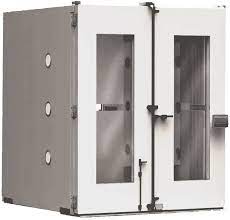Introduction
Thermal shock test chamber technology is a fascinating and crucial aspect of product development and quality control across various industries. In this article, we will delve into the world of thermal shock test chambers, understanding what they are, how they work, and why they are indispensable in today’s fast-paced manufacturing landscape.
Unveiling Thermal Shock Test Chambers
What Are Thermal Shock Test Chambers?
Thermal shock test chambers are specialized testing equipment designed to subject products and materials to extreme temperature variations rapidly. This process helps assess how well they can withstand sudden temperature changes without compromising functionality or structural integrity.
The Inner Workings
- Two-Chamber Design: Thermal shock chambers typically consist of two chambers – one hot and one cold – separated by a movable basket or door.
- Rapid Temperature Transition: The test begins by placing the specimen in one chamber at an extreme temperature, then quickly transferring it to the other chamber with a different temperature.
- Precise Control: Advanced thermal shock chambers offer precise control over temperature and transition times, ensuring accurate testing.
- Measurement and Monitoring: Sensors within the chamber monitor the specimen’s response to the temperature shock, collecting crucial data.
The Significance of Thermal Shock Testing
Quality Assurance
Thermal shock testing is a vital tool in quality assurance. It helps identify potential weaknesses in product design or materials, ensuring that only robust and reliable products reach the market.
Reliability Assessment
Manufacturers use thermal shock testing to assess the reliability and durability of products, particularly those used in extreme environments, such as aerospace and automotive components.
Applications Across Industries
Electronics Industry
- Semiconductor Testing: Thermal shock chambers are used to evaluate the reliability of semiconductor components under extreme temperature fluctuations.
- Consumer Electronics: Products like smartphones undergo thermal shock testing to ensure they can withstand temperature changes without malfunctioning.
Automotive Industry
- Engine Components: Engine parts and sensors are tested to ensure they can endure the temperature variations experienced in vehicle engines.
- Automotive Lighting: Headlights and taillights are subjected to thermal shock testing to guarantee their functionality in varying weather conditions.
Aerospace Industry
- Avionics Testing: Avionic components must function flawlessly in the extreme conditions of the sky. Thermal shock testing ensures their reliability.
- Spacecraft Components: Components destined for space travel must withstand rapid temperature changes, making thermal shock testing crucial.
Advantages of Thermal Shock Test Chambers
Accelerated Testing
Thermal shock chambers expedite the testing process by simulating years of temperature changes in a matter of hours or days, saving both time and resources.
Improved Product Reliability
By identifying and addressing weaknesses early in the development stage, thermal shock testing leads to more reliable and durable products.
Conclusion
In an era where product quality and reliability are paramount, thermal shock test chambers are indispensable tools in various industries. Their ability to subject products and materials to extreme temperature variations ensures that only the most resilient and dependable items make it to the market.













